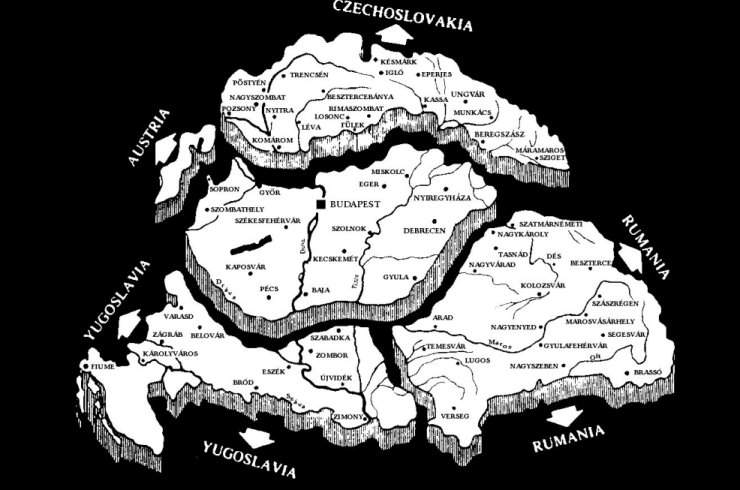Trianon peace treaty 100: was there a chance to preserve Greater Hungary?

It will probably be an ever-lasting debate among Hungarians whether there was a chance or not. The author of the latest publication regarding the issue argues that what had happened was not only the government’s fault and that preserving the multi-ethnic Kingdom of Hungary would have been impossible.
Those interested in the post-WWI events know that there are success stories in modifying the peace treaties that concluded the bloody war. The successor of the Ottoman Empire, Turkey, led by Kemal Atatürk, not only became a secular, modernised republic but also managed to rewrite the peace treaty of Sevrés (1920). Therefore, they could gain some of their lost territories, such as Izmir and its neighbourhood in the Treaty of Lausanne (1923).
Many say in Hungary that, provided the country
followed the Turkish example in 1918-1920,
it could have received a better peace treaty, meaning it would not have lost 2/3 of the Kingdom of Hungary with more than 3 million Hungarians.
Now, 24 asked Tamas Révész, a Hungarian historian dealing with the issue in his latest publication, what the chances of fighting back were. He said that in November 1918,
1,328 million Hungarian soldiers were fighting on three fronts:
the Western and the Italian fronts where there were brutal fights and the Eastern one where they were occupying territories that the Brest-Litovsk treaty (March 1918) granted for the Austro-Hungarian Monarchy. Most soldiers wanted immediate peace, and the chance for that came on November 3, 1918, when the armistice agreement was signed. Then, 1 million of them came home unorganised, incapable and unwilling to continue the fight while 320 thousand travelled home with their officers in closed ranks. However, they did not want to fight either.
Meanwhile, the pacifist Hungarian democratic government held only the 5 youngest generations in arms which resulted in the fact that, at the end of November,
there were only 37 thousand soldiers against the invading Romanian, Serbian, and Czechoslovak forces.
The government did not have a defence concept, and in its foreign policy, they trusted that a democratic Hungary granting wide-range autonomy for its minorities would not only be attractive for the Serbs, Romanians, or Slovaks but also for Paris and the winning powers there to write the peace treaties.
The Károlyi government could not have been more wrong. In Paris, France gained the right to dictate the new order of Central Europe, and they wanted to strengthen their local allies (Romania, Czechoslovakia, Poland, and Serbia) as much as they could.
Furthermore, since the Kingdom of Hungary was centralised, there were no Hungarian local leaders who had the prestige to start a fight against the intruders. Balassagyarmat, where locals took up the fight and won against the Czechoslovak army in January 1919, or the story of
the Szekler Division fighting on the Western border of Transylvania between December 1918 and April 1919 are just episodes but not parts of a central project.
The Károlyi government believed that if they had taken up the fight, the great powers would have thought that Hungary wanted to continue the war, so they would have never invited it to the peace conference.
Károlyi realised too late that if they wanted to preserve the borders of Hungary, they had to fight even if they grant territorial autonomy for the ethnic minorities because that, in itself, was far from enough.
It was not until March 2, 1919, when PM Mihály Károlyi said openly that
the government is resolved to fight.
Three months later, the Social-Democrats agreed with the Communists, and Hungary became the second Socialist republic in the world after the Soviet Union. Therefore, it did not receive an invitation to the peace conference.
Tamas Revesz said that, provided the Hungarian army fought back, some of the lost territories could have been preserved in Transylvania or Czechoslovakia, but there was no chance to maintain the borders of Greater Hungary.
Source: 24.hu


Had Horthy refused signing it, maybe. But we were sold.
“A peace treaty is an agreement between two or more hostile parties” – therefore this “Peace Treaty” is invalid. Hungary was not allowed to take part in the negotiations, what kind of “negotiation” was this? Horthy’s official representative, Count Appony refused to sign it. Some low rank people signed it.
The writer is most likely not familiar with the Allied Entente scam behind this: The Allies offered the Romanians the territory of Transylvania (Erdely), if they enter the war against Austro-Hungary. Similarly, South Tirol was promised to Italy for entering the war on the Allied side. So the scam is that the Allies offered payment by properties not belonging to them.
Breaks my heart every time I see what Hungary was and now is.
Maybe if the hungarians could’ve developed the atomic bomb in 1919 then yeah… totally…